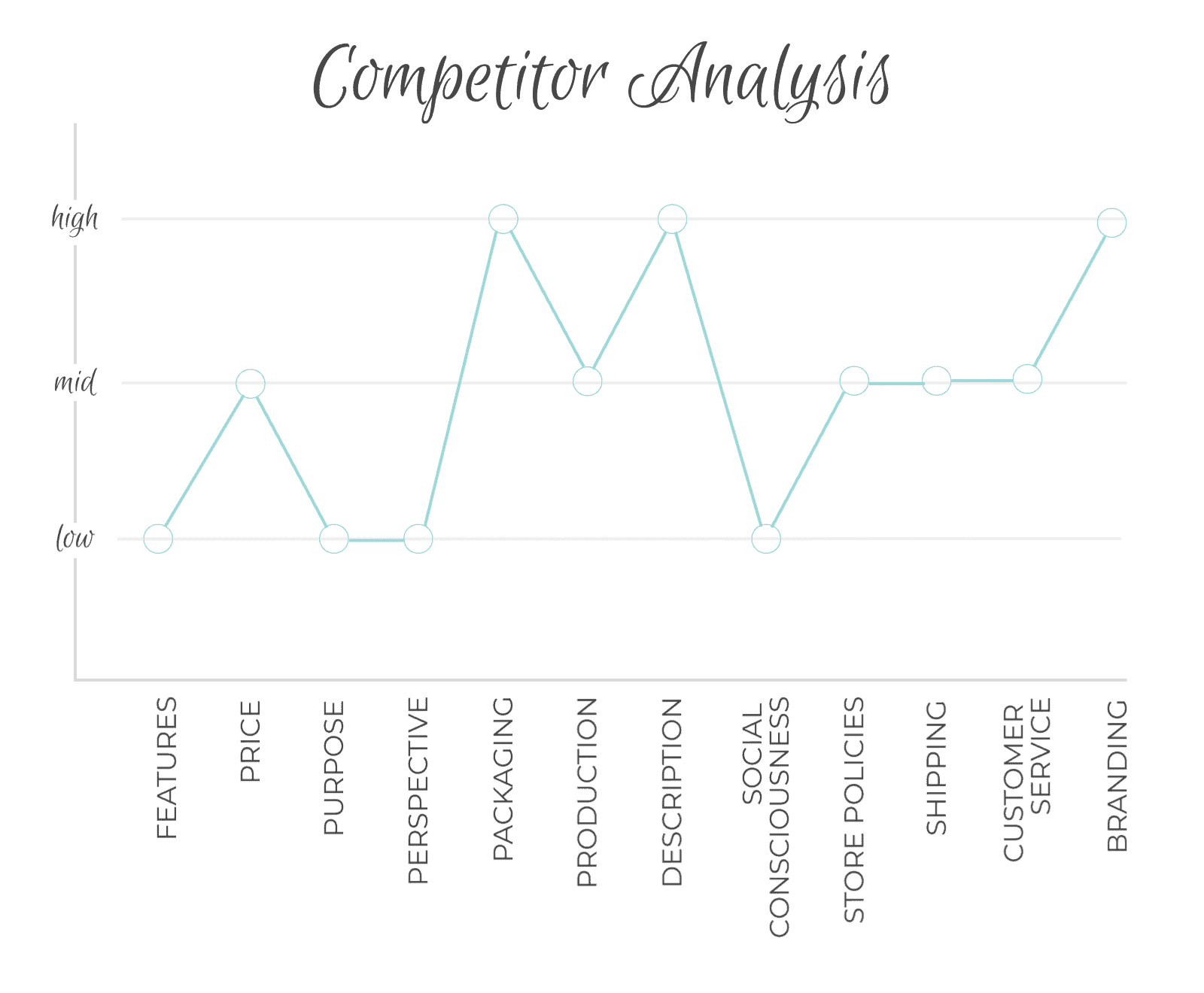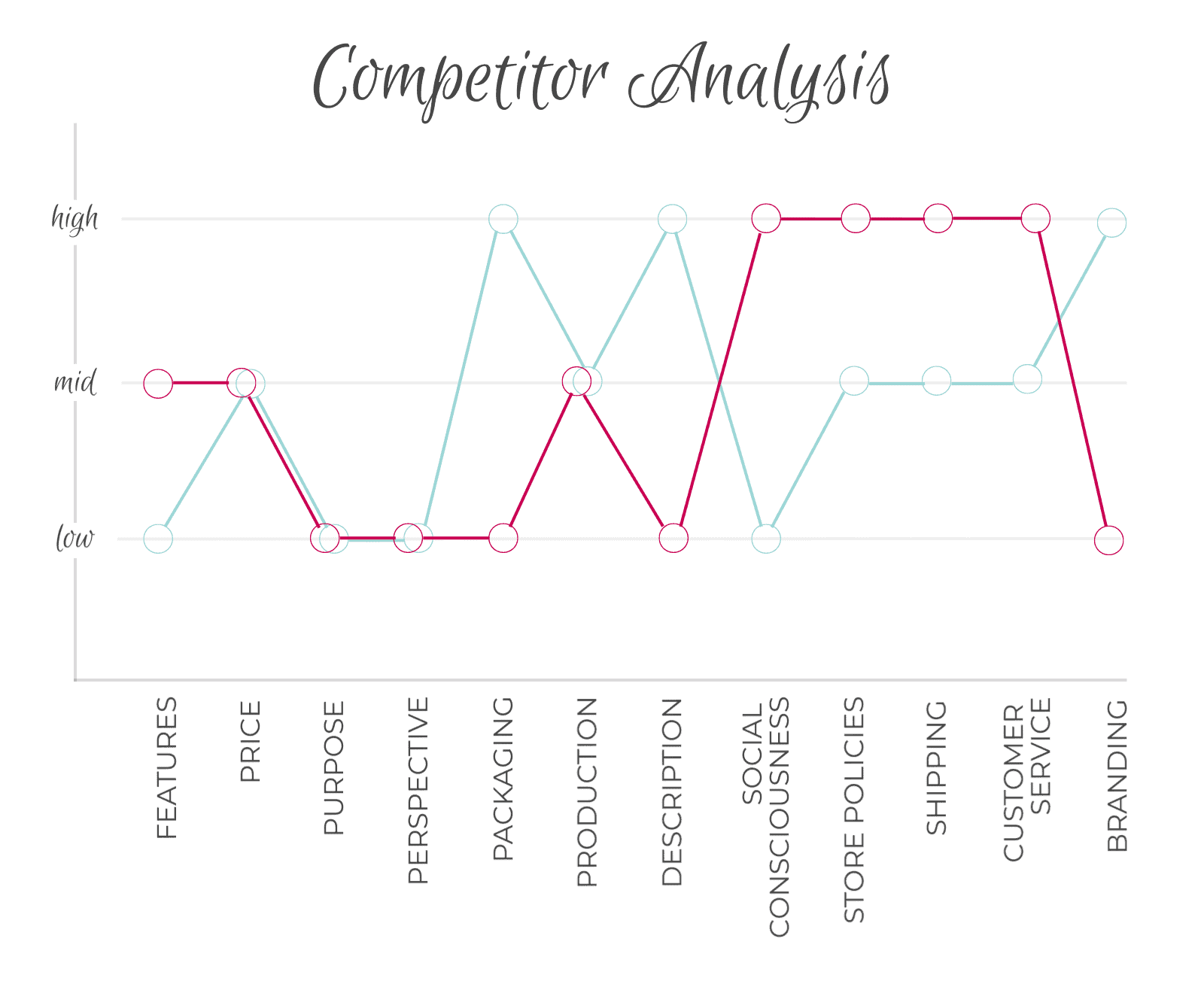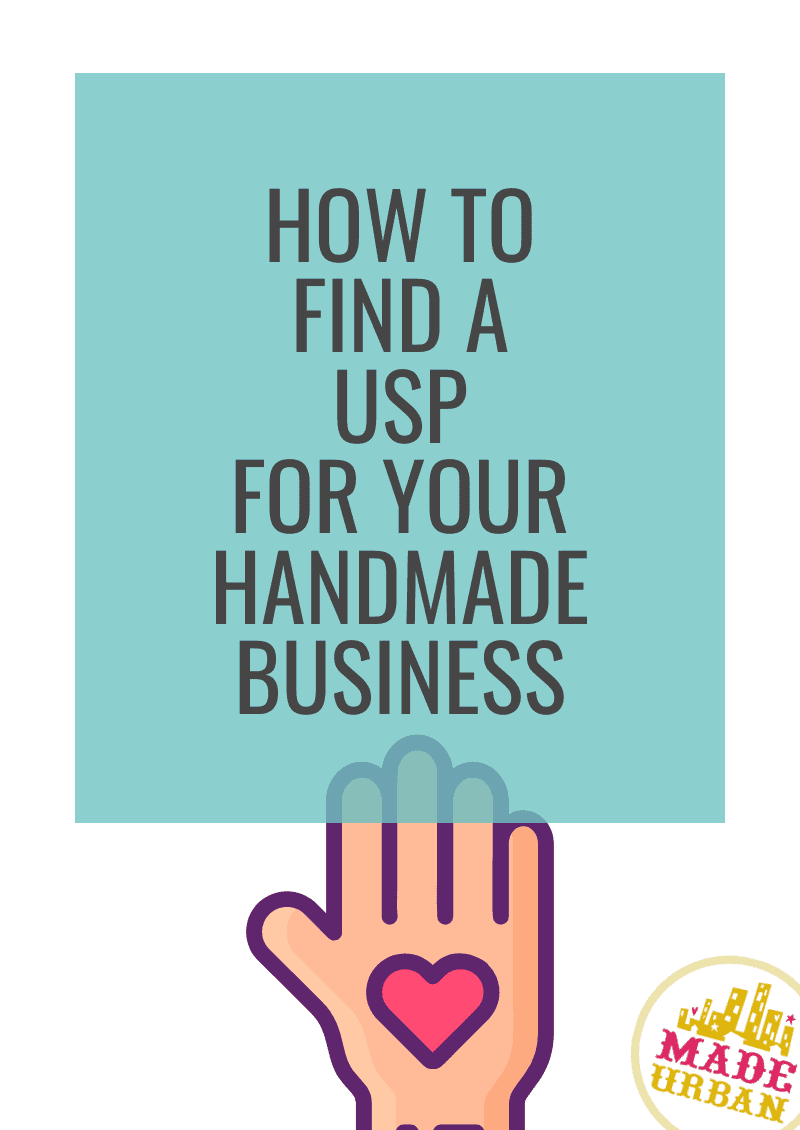How To Find a USP for your Handmade Business
USP stands for unique selling position. In simple terms, it tells shoppers who your product is for, what makes it different and why they should purchase from you. There are different ways to develop a unique selling position but the formula I like to follow is:
Niche Market + Niche Product + Benefit = USP
The broader the audience you serve, the more competition you’ll have, making it harder to define what sets your product apart.
And the more products you offer, the bigger the businesses you compete with.
>> “A one-stop shop for all your home décor needs” puts a vendor in competition with every home décor business out there and up against multi-million dollar retailers.
>> “Lumberjack inspired pillows & throws for the man cave” narrows the audience (men who are married, are homeowners and have a room to decorate in their style) as well as the type of product (pillows and throws). A big chunk of competition is removed and it creates a niche most retailers don’t tailor to and a product they may even be interested in carrying.
The last step is to uncover the benefit your business or products provide. This must be viewed from the consumer’s perspective. Take off your maker cap and step into a shopper’s shoes; what do they care about?
You may take great pride in your attention to detail and spending an hour to complete each piece, but that isn’t meaningful to consumers unless you explain the benefit to them.
“Attention to detail” may translate to “a laptop bag with seams that hold for a lifetime” or “a five-step ingredient selection process for effect skincare products”.
Here are 4 steps you can take to come up with your business’s USP and put it to work.
STEP 1 – CHECK OUT THE COMPETITION
Before you can determine what you do differently you must research competitors. You may think you have a one-of-a-kind idea only to find hundreds of similar options after a quick Google search. However, you can still find a unique angle by looking at what the competition does well and where you can do better.
For example, someone who paints custom quotes on reclaimed wood may have a slow turnaround time. Customers love their purchases but complain about the wait. On a scale of speediness, the business would rank low, giving another artist an opportunity to move ahead by offering a similar product but delivering it faster.
Use the following steps to check out competitors’ products and customer service to determine any areas you can improve upon.
SEARCH YOUR NICHE PRODUCT
If you simply type “earrings”, “knitted scarves”, “paintings”, etc. into a search bar, the results will vary and make it hard to determine how you stand out in your niche.
Instead, search niche product names such as “tassel earrings”, “ethically sourced chunky wool scarf” or “pet portrait oil painting” to find your real competitors.
Enter your niche/specific product name into Google and note the top results. See if you can find:
- An independent website (e.g. the website of another handmade vendor)
- A large website (e.g. a department store or major brand)
- A handmade marketplace website (e.g. a shop on Etsy)
- A social media website (e.g. a Facebook page or Pinterest board)
EXAMINE YOUR COMPETITORS
As you look through the Google results, pay attention to:
- Features – is the market oversaturated with certain colors, styles, scents, flavors, shapes, sizes, etc.? Are there any options that aren’t offered?
- Price – what’s the average price point of products similar to yours? If your prices are much higher or much lower, your USP should communicate why.
- Purpose – are there additional benefits of their products? For example, pendant necklaces that also have initials stamped on the back to celebrate a relationship.
- Perspective – what’s the meaning behind their products? Do they have a strong message? For example, a jewelry business may be against fast fashion and focus on timeless pieces that won’t end up in the landfill.
- Packaging – is there anything unique or over the top about their labels, tags, packages or wrapping? Is it detailed and on brand?
- Production – is there anything they do differently when it comes to how they create their products and the materials or tools used?
- Description – are their descriptions short and seem quickly thrown together or do they paint a detailed picture and make you feel as though you want to try their product?
- Social consciousness – do they give back in any way by donating a portion of sales or profits? Are they doing their part for the environment by using eco-friendly materials, processes and packaging?
- Store policies & shipping – what are common turnaround times, shipping costs and rules when it comes to returns or exchanges? Are their shipments carbon neutral?
- Customer service – what’s the feedback from customers? Which products have the highest ratings, most ratings, most pins, likes, etc. What do customers complain about? If many dock points for the color not being as vibrant as it appears in photos, there may be an opportunity to deliver the most vibrant colored products and please more customers.
- Branding – do they have a strong branding that’s present in all aspects of their business?

EXAMINE YOUR PRODUCTS & BUSINESS
For each element, rate your business as low (below average), mid (average) and high (above average) based on how you stack up against competitors. Note how you can step it up in areas you fall below their score and how you can jump ahead where their ratings are low.

Using this example, compared to their competitors, the vendor has opportunities to move ahead by improving their purpose, perspective and production. They should also improve their packaging, descriptions and branding to rise to their competitors’ level.
STEP 2 – BUILD YOUR USP
Your USP must be authentic so it’s important to know what your competitors are doing but not position your entire business around them. You must keep your niche market and ideal customer in mind, the product you love to make and the reason you make it.
Your USP should combine:
(A) niche market + (B) niche product + (C) benefit
A) Niche Market
Which part of the market are you targeting? You may have gotten specific and niche enough when you chose your target market, or you may need to narrow down further.
For example, if a vendor making hair accessories decides to target brides, their USP’s niche market would be “Brides”.
However, there are many hair accessory businesses targeting brides so they may explore more specific options and revisit their target market’s demographics, psychographics, physical attributes and personal preferences to add another unique layer. For example:
-
- Demographics – target women who are getting married someplace tropical or having a winter wedding.
- Psychographics – create accessories for brides planning their wedding around a specific interest, such as Harry Potter, Game of Thrones or a sports theme.
- Physical attributes – target brides with short hair or a specific hair color, such as red.
- Personal Preference – target brides who prefer a specific style or color, such as vintage, bohemian or the color pink.
The vendor may decide to target brides who like a bohemian style.
Their USP’s niche market would now be “Bohemian Brides”, which is more specific and starts to create a unique angle.
Also, consider your competitor research and look for a segment of the market that’s underserved. Be careful you don’t get too specific with who you target. If you can’t find competitors it may be a sign that there’s no demand from the market.
Someone selling teething necklaces may notice trendy young moms have a lot of options in silicone teething necklaces with colorful, oversized, geo-shaped beads. But the mom who has a more classic and minimalistic style doesn’t have as many options. The competition is leaving a gap in the marketplace to fill.
Decide if becoming more specific in your niche market would help your business stand out. If it would, explore the demographics, psychographics, physical attributes and personal preferences again.
B) Niche Product
Now add the niche your products fall under to your niche market to see how your USP is developing. Is your product serving the needs of your niche market or can you be more specific based on your customer’s passions, problems or preferences?
For example, “hair accessories for bohemian brides” is a good start to a USP but there is room to differentiate even more. A vendor may come up with the following product passions, problems, and preferences based on their niche market:
-
- Passions – they may love nature, the woods, and wildflowers
- Problems – finding hair accessories to suit the entire bridal party
- Preferences – they may love the look of floral crowns
Although a vendor offers several pieces, they may decide to focus on floral crowns, as that’s what they want to be known for and what gives them an opportunity to stand out.
Their USP now becomes “floral crowns for bohemian brides”.
Remember, your USP doesn’t have to cover every product you offer, just your main focus.
If a vendor focuses on organic aromatherapy bath & body products for stress relief but also sells lip balm and a few non-aromatherapy products, they would center their USP on the organic, aromatherapy products.
If adding your niche product to your niche market isn’t helping you create a unique angle, revisit your product and see if you can be more specific or simply shine a spotlight on one type of product you offer.
C) Benefit
The benefit will be the problem your product or business solves, the good feeling it evokes, or the goal you help people achieve. But remember, it should be unique.
The benefit must also be clear to the consumer. Cold process soap may produce a mild cleanser but “cold processed” or “mild cleanser” isn’t the benefit; “won’t cause dry, tight skin” is.
Your product may have an obvious unique benefit (e.g. leak-proof travel pouches to keep liquids from leaking on other items in a suitcase) or you may need to explore other aspects of your product and business to find a unique angle.
The “benefit” part of your USP is what persuades people to buy since they care about the “why” more than the “what”.
When you need a new pair of earrings you don’t buy just any pair; you go on the hunt for a pair that make you feel stylish, sexy, cute, or classy.
Think about what people gain or avoid by purchasing your products and how they want to feel when wearing, using, displaying or consuming them.
For example, the vendor making floral crowns for bohemian brides may explore these potential benefits:
-
-
Products
- Purpose – each crown could incorporate blue to be a bride’s “something blue”, they may aim to evoke romance, or give back by working with businesses that accept food, flower or dress donations after a wedding celebration.
- Perspective – the maker may believe flowers are a symbol of love and every bride should wear one in her hair.
- Production – the highest quality silk flowers may be used to ensure the crowns look natural and realistic while being waterproof and fade resistant, and maintain their color and texture forever.
-
Customer service
- Before – they make it easy for brides to pick out the most suitable crown based on face shape, hair color and hair length by showing a photograph of each style on a variety of models.
- During – brides are kept up to date every step of the ordering and fulfillment process, so there’s no stress wondering if their order will arrive on time.
- After – they may allow unlimited exchanges until the bride finds the perfect floral crown.
-
Products
The vendor has several options they could point out in their USP and may consider a few:
-
- “Everlasting silk floral crowns for bohemian brides” would communicate the benefit of using silk flowers.
- “Floral crowns for bohemian brides. Unlimited exchanges until you find the perfect one” helps brides feel confident and at-ease and removes the fear of buying an item they can’t try on when shopping online.
- “Romantic floral crowns for bohemian brides” helps evoke a positive feeling (romance) every bride wants on their wedding day.
Define the benefit your products provide and ensure it’s one that answers the shopper’s question “What’s in it for me?”
Once you have your niche market, niche product and benefit clearly defined, combine them into a sentence to form your unique selling position.
STEP 3 – TEST YOUR USP
Once you’ve narrowed down your unique selling point, make sure it checks all the boxes of a good USP.
- Relevant – will shoppers care about the points covered in your USP?
- Unexpected – are you one of the few businesses with this offering?
- Specific – is “who”, “what” and “why” clear in your USP?
- Simple – is your USP easy to remember?
- Consistent – is your USP present in several aspects of your business?
- Emotional – does your USP evoke a good feeling?
- Honest – can you stand behind your USP’s claims?
What’s most important is that it converts people from shoppers to customers.
Read your USP and ask: will people buy my product because of it?
Meaning, if it comes down to you and your competitor, will pointing out your USP encourage someone to spend their money with you?
STEP 4 – APPLY YOUR USP
Your USP is more than just a tagline; it should be communicated in several written and spoken areas so it’s not missed.
Let’s say a bride landed on a listing page for a floral crown, instead of the home page where they might read the tagline “Everlasting Silk Floral Crowns for Bohemian Brides”. If the product itself, product title, and description don’t communicate “everlasting”, “silk”, “floral”, “bohemian” and “bridal”, the message is lost and it’s just another business selling hair accessories.
Your USP may come across in many written or spoken messages. For example:
PRODUCT
- Labels
- Tags
- Packaging
MARKETING
- Paid Marketing – ad text
- SEO (search engine optimization) – keywords, blog articles, etc.
- Social Media – bio, posts, etc.
- Email marketing – messages, signature, etc.
- Cross promotion – bio section of a guest post
- Events – your elevator pitch
- Media relations – press releases, interviews, etc.
- Print materials – tagline on business cards, postcards, etc.
- Guerilla marketing – signage
SALES CHANNELS
Website
- Home page – tagline
- Product pages – title, description
- Shopping Cart – thank you message, invoice
- Pop-ups – text on a newsletter sign up form
- Bio – why you started your business
- FAQ section
- Shipping & Store policies
- Shipping parcels – on stickers to seal boxes, stamps on boxes or bags
Events
- Signage
- Sales pitch
- Product wrapping – stickers to close boxes or seal tissue paper
- Shopping bags – stamps or stickers on bags
Retailers
- Lookbook
- Line sheets
- Hangtags
- Packaging
Examine your sales channel and make a note of the areas you can communicate your USP.
You may also be interested in:
- How To Find the Correct Target Market for your Craft Business
- 8 Mistakes Handmade Businesses Make with their USP
I hope this article helps you find a unique selling position for your craft business. Please let me know in the comment section if you have any questions!


Hey, I’m Erin 🙂 I write about small business and craft show techniques I’ve learned from being a small business owner for almost 2 decades, selling at dozens of craft shows, and earning a diploma in Visual Communication Design. I hope you find my advice helpful!

Hello Erin I like your suggestions for the USP. formulate and make my natural plant based skincare and aromatherapy oils targeting perimenopausal and menopausal women. I also make gentle melt pour soap, bath products too. I am going to a Christmas show. Would you suggest that I eliminate the gentle natural soaps and focus only on the skincare?
Hope to hear from you. Sylvia in Canada
Hi Sylvia,
Thanks for commenting! Wow, that sounds like a great direction for your business. Your website and products look amazing!
I think it’s perfectly fine to offer your soaps and bath products. If you were also selling something like jewelry, that would be different. But your other bath products don’t confuse your message and are something someone buying a skincare item might also buy.
Also, regarding craft show items, I think having the soaps and bath products may be beneficial. I think you have a great target market (perimenopausal and menopausal women), but depending on the target market of the craft show, you may or may not get a lot of your ideal customers showing up to the show. So having something a little more general (the soaps), but still within your niche, may help you make more sales.
If you do find you reach your target market through craft shows, then I would consider putting the “menopausal” spin on all of your products (the soap and bath products).
Craft shows are a great place to test products and gather consumer information.
But you sound like you’re on a great path.
I hope that helps!
~Erin